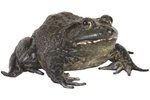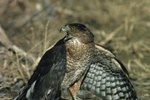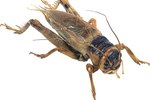
Tree frogs or hylids, represented by more than 700 species worldwide, inhabit much of North, Central and South America as well as Australia and New Guinea. Over their vast range, hylid species live varying lifestyles, and reside in various habitats; some tree frogs are actually terrestrial or even fossorial. They thrive despite intense predatory pressure everywhere they live, applied especially well by snakes, birds, carnivorous mammals and fish.
Snakes
Snakes are especially important predators of tree frogs. Snakes largely search for prey via chemical cues, rather than visual ones, negating the camouflage protection most tree frogs possess. Additionally, many snakes are accomplished climbers that can ascend trees as well as tree frogs can. Juvenile rat snakes (Pantherophis sp.) and tree boas (Corallus sp.) are among the species that predate heavily upon frogs.
Carnivorous Mammals
Otters, raccoons and squirrels eat tree frogs. The sharp eyesight and dexterous hands of these two mammals assist in locating and manipulating their amphibian prey. Sometimes frogs are caught in trees, but they are most often caught when traveling to and from breeding sites. At least one species of bat regularly predates upon calling frogs, able to discern edible species from toxic species by call alone.
Birds
Birds typically have excellent eyesight and are capable of finding even the most well-camouflaged tree frogs. In fact, one hylid, the bird-poop frog (Theloderma asperum) tries to evade the attention of birds by disguising itself as something the birds never look for: bird droppings. Blue jays (Cyanocitta cristata), owls (Strix sp.) and red-shouldered hawks (Buteo lineatus) are species that regularly feast on tree frogs.
Fish
It is important to remember that most frogs, including tree frogs, spend the first part of their life in the water as tadpoles. During this time, they are hunted by other amphibians, insects and, most importantly, fish. Many tree frogs, like grey tree frogs (Hyla versicolor) avoid fish predation of their young by depositing eggs only in water without fish, such as temporary puddles. Other frogs, such as green tree frogs (Hyla cinerea), are resistant to fish pressure, for reasons that aren't entirely understood.
References
- Animal Diversity Web: Hylidae
- Savannah River Ecology Laboratory: Rat Snake
- Animal Diversity Web: Hyla Versicolor
- Animal Diversity Web: Hyla cinerea
- The Ecology and Behavior of Amphibians; Kentwood D. Wells
- Montclair State University: Frog Eating Bats
- Animal Diversity Web: Corallus Hortulanus
- Seaworld.org: Otters
- Pelotes Island Nature Preserve: Raccoon (Procyon lotor)
- The Featured Creature: Bad Day? At Least You’re Not a Bird-Poop Frog!
Resources
Photo Credits
-
NA/AbleStock.com/Getty Images




